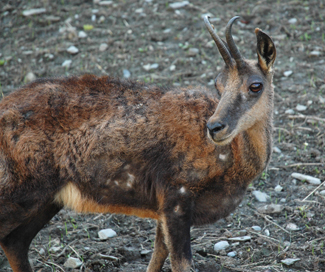Border Disease virus infection settles down in Catalan Pyrenees

Border disease virus (BDV) is one of the four main viral species recognized within the genus Pestivirus in the family Flaviviridae. Border Disease (BD) affects mainly sheep and goats, and has substantial loss-related economic implications world-wide. In addition to cattle, goats, sheep and pigs, ruminant pestiviruses have been isolated from many other wild ruminant species, and serologic surveys have demonstrated prior infection with pestiviruses in more than 40 species worldwide, but there are few confirmed cases of isolation of a ruminant pestivirus and disease, and there is no evidence that they have significant population impacts on free-ranging animals. However, an outbreak of a previously unreported disease, associated with a new pestivirus belonging to the BDV virus cluster, was reported in Southern chamois (Rupicapra pyrenaica) in the Catalan Pyrenees (NE Spain) in 2001 and 2002, and was supposedly responsible for a population decrease of 40-45 % in the most affected areas.
Between 2002 and 2006, sera and/or tissue samples taken from 116 healthy chamois shot during the hunting season, plus 42 from chamois affected by different diseases, were studied. A blocking enzyme-immunosorbent assay (ELISA) was used to study pestivirus seroprevalence in 114 healthy hunted and 31 diseased chamois, yielding positive results in 73.7% and 22.6% of the chamois respectively. Virological investigations for pestivirus detection were performed using an antigen ELISA test in 82 healthy and 18 diseased chamois, RT-PCR in 16 healthy and in all diseased chamois, and virus isolation in 14 diseased chamois.
Figure 2. Head of a chamois with infection associated to a Border Disease Virus, with alopecia and skin hyperpigmentation.
No viral antigen was detected in any of the healthy animals. A pestivirus, characterized as BDV by monoclonal antibodies, was detected in the 10 chamois showing clinical signs consistent with BDV infection. Sequence analysis in the 5’ unstranslated region (5’-UTR) revealed that they were grouped into the BDV-4 genotype. In the remaining chamois, infectious keratoconjunctivitis, pneumonia, trauma and contagious ecthyma were diagnosed. The results suggest that the infection with BDV has become endemic in the population and that it could have a significant impact on chamois population dynamics.
Servei d'Ecopatologia de Fauna Salvatge
References
Epidemiological study of border disease virus infection in Southern chamois (Rupicapra pyrenaica) after an outbreak of disease in the Pyrenees (NE Spain). Marco, I; Rosell, R; Cabezon, O; Mentaberre, G; Casas, E; Velarde, R; Lopez-Olvera, JR; Hurtado, A; Lavin, S. VETERINARY MICROBIOLOGY, 127 (1-2): 29-38 FEB 5 2008


